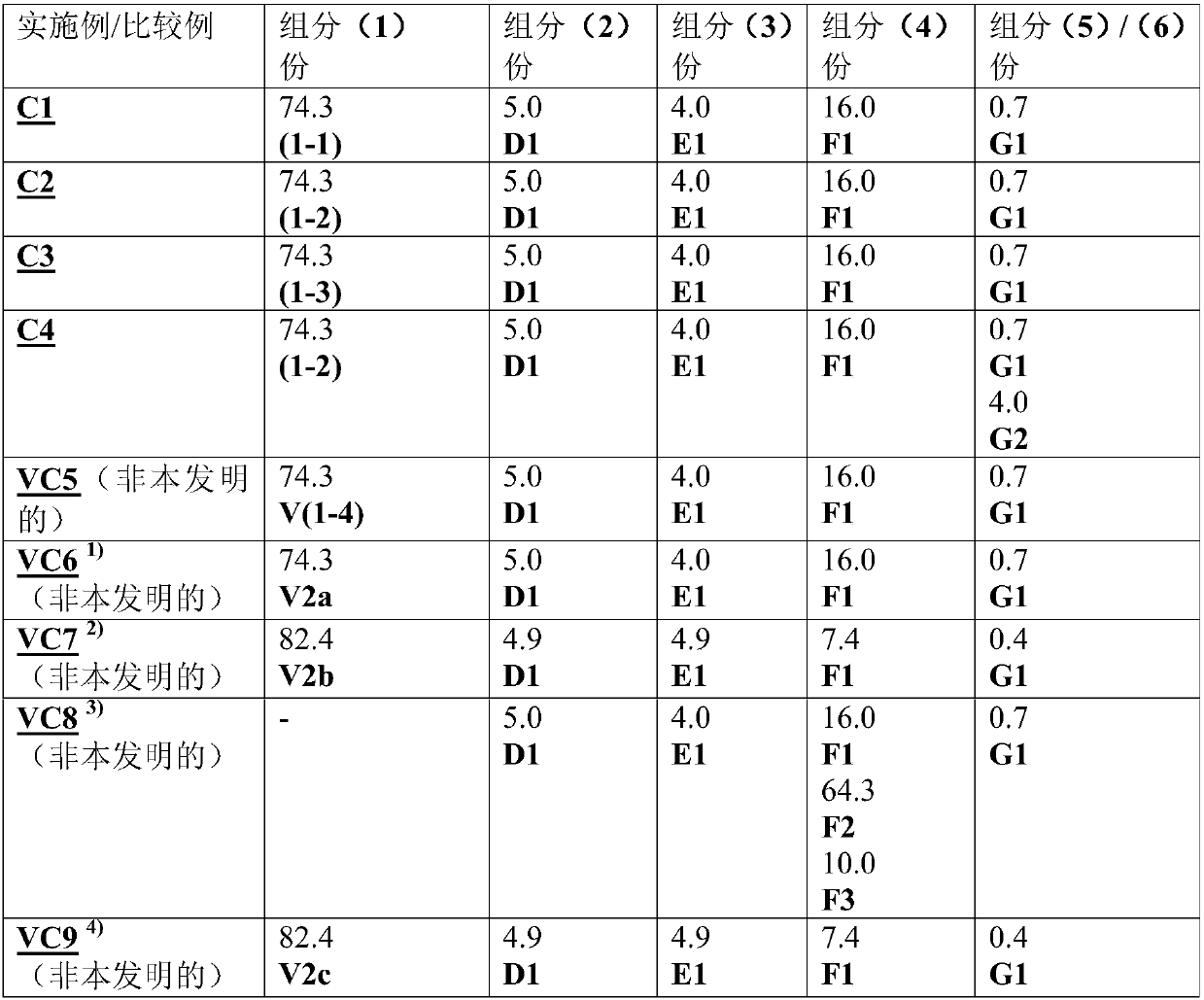Defoaming formulations containing organopolysiloxanes
A technology of polysiloxane and defoamer, which is applied in the direction of defoamer, anti-foam pulping process, detergent compounding agent, etc., and can solve problems such as difficult to handle products, uncertainty, poor reproducibility, etc.
- Summary
- Abstract
- Description
- Claims
- Application Information
AI Technical Summary
Problems solved by technology
Method used
Image
Examples
Embodiment 1
[0258] Production of organosilicon compound (A):
[0259] a) Silicone compound A1 :
[0260] In a 500ml three-necked flask, the balance (equilibrate) of dimethylsiloxy and vinyldimethylsiloxy units with an iodine value of 101.0g of 22.0 and 2.7g of trimethylsiloxy units ( Trimethylsiloxy unit) end-blocking and hydrolyzate of hydromethyldichlorosilane with a chain length of about 55 Si units, 120.0g OH-end-blocking polydimethylsiloxane (viscosity of 62mm 2 / s) (25.0°C; capillary number II) and the balance of 28.6g dimethylsiloxy and trimethylsiloxane units (viscosity of 35mm2 / s) (25.0°C; capillary number II) with 250ppm of PNCl 2Equilibrate for two hours at 120° C. and a reduced pressure of 20 mbar. by adding NaHCO 3 deactivate the catalyst. After filtration and removal of volatile components at 160 °C and a reduced pressure of 40 mbar, the polysiloxane is obtained A1 , its viscosity is 81mm 2 / s (25.0°C; capillary number II), the iodine value is 13.3, and the H content...
Embodiment 2
[0268] Production of organopolysiloxane (1):
[0269] a)Organopolysiloxane (1-1) :
[0270] In a 250 ml three-necked flask, 100.0 g of polysiloxane was dissolved in 50 ml of xylene together with 0.2 g of Karstedt Pt catalyst in toluene solution (Pt content: 0.3% by weight) A1 Heat to 90°C for 3.5 hours. During the final cooling, 0.3 g of diallyl maleate was added. The xylenes were removed at 90° C. and a reduced pressure of 32 mbar. A polysiloxane with a viscosity of 425 mPas (measured at 25°C and a shear rate of 11 / s) was obtained (1-1) .
[0271] organopolysiloxane (1-1) The production therefore uses only polysiloxane A1 , so the main component is the structural unit (IV), where x=52. (1-1) Is in the form of a flowable compound that does not tend to gel. Therefore it is not necessary to use inert solvents.
[0272] b)Organopolysiloxane (1-2) :
[0273] In a 250ml three-necked flask, 100.0g polysiloxane A2 With 55.0 g of linear vinyldimethylsilyl-terminated pol...
Embodiment 3
[0295] Production of antifoam formulations C1-C4 according to the invention comprising organopolysiloxanes (1) and production of antifoams not according to the invention Dosage formulations VC5-VC9:
[0296] To produce antifoam formulations, the substances described in Table 1 were mixed with a dissolver and heated to 150°C in the presence of 1500ppm KOH (20% methanol solution) for 4 hours, and after cooling, the dissolved Homogenize again.
[0297] Table 1 Composition of the defoamer formulation
[0298]
[0299] 1) Comparative Test VC6 according to EP 516 109 A1
[0300] 2) Comparative Test VC7 according to EP 434 060 B2
[0301] 3) Comparative test VC8 according to WO 2011 / 069868 A2
[0302] 4) Comparative test VC9 according to EP 217 501 A2
[0303] Substances used:
[0304] D1: BET surface area is 300m 2 / g of hydrophilic pyrogenic silica (available from Wacker Chemie AG, Germany under the trade name T30 obtained)
PUM
| Property | Measurement | Unit |
|---|---|---|
| boiling point | aaaaa | aaaaa |
| viscosity | aaaaa | aaaaa |
| particle diameter | aaaaa | aaaaa |
Abstract
Description
Claims
Application Information
 Login to View More
Login to View More - R&D
- Intellectual Property
- Life Sciences
- Materials
- Tech Scout
- Unparalleled Data Quality
- Higher Quality Content
- 60% Fewer Hallucinations
Browse by: Latest US Patents, China's latest patents, Technical Efficacy Thesaurus, Application Domain, Technology Topic, Popular Technical Reports.
© 2025 PatSnap. All rights reserved.Legal|Privacy policy|Modern Slavery Act Transparency Statement|Sitemap|About US| Contact US: help@patsnap.com



